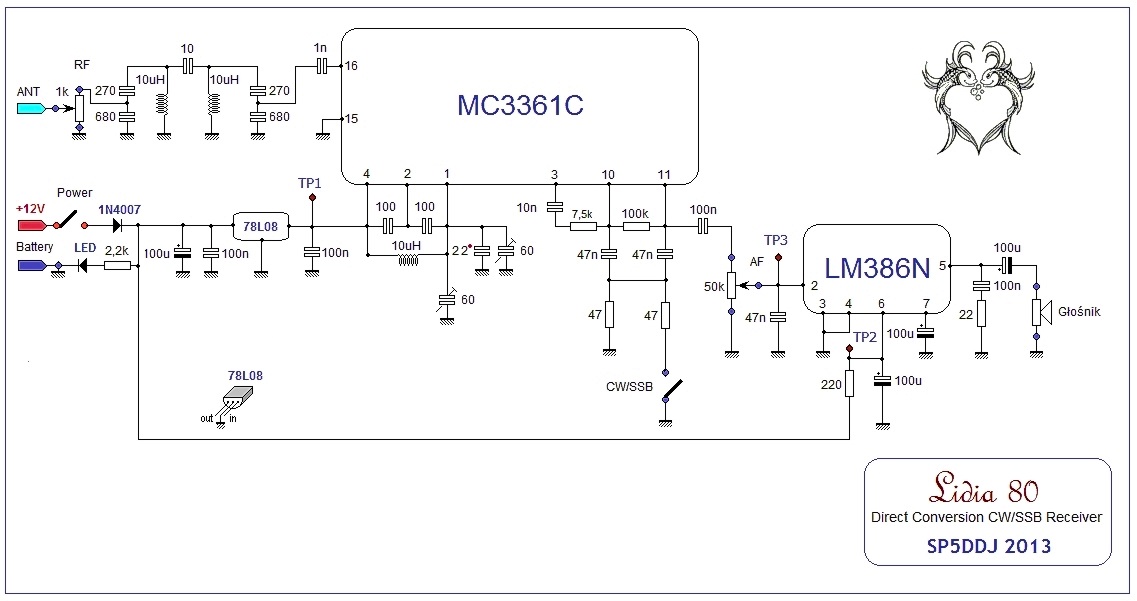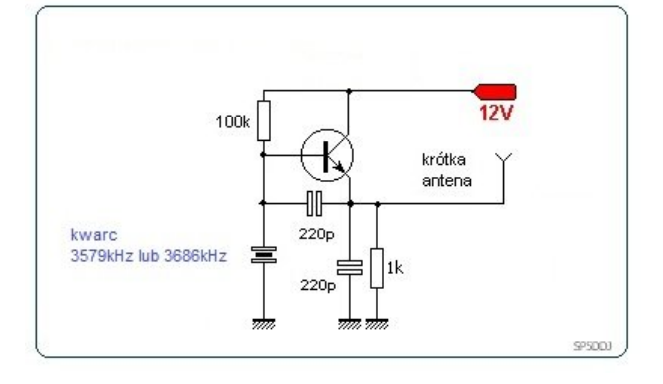How exacly 80m ARDF works?
I have found such project:
http://www.open-circuit.co.uk/atx80.php
AN 80M TRANSMITTER FOR RADIO ORIENTEERING by G3ZOI
But I don't understand how it works....
1. What is exacly transmitted? Is this a morse code generated by PIC or what?
2. Can I receive it with 80m SSB/CW transmitter?
3. How hard would it be to modify schematic from link to transmit the voice?
In case of DEAD LINKS, I am insnerting the schematic in the attachment!
ATX80-v3-pnp.pdfatx80-v3-partslist.txtATX80-v3-layout.pdfATX80-v3-dia.pdf
Thanks in advance!
1. yes, simple CW Morse Code
2. You can't receive anything with a transmitter! But you can pick it up with any CW/SSB receiver.
3. very difficult as it has no modulator as such. But why would you want to do that?
It is intended to be hidden as a target for a direction finding contest. It sends CW identification periodically and the fun is in different teams using direction finding receivers to see who can locate it quickest.
Brian.
SORRY I meant "CW/SSB 80m receiver". Of course I wouldn't want to receiive soemthing with transmitter.
Well I have bought a "80mm receiver kit" but I don't know how am I supposed to test it after the assembly... what would you suggest? I don't even have a good antenna for that, so I tought that I will also make a transmitter and try to pair them,...
That might be counter productive as you would have no way to confirm which wasn't working if you didn't pick anything up! You also need a license to operate the transmitter which might involve an examination depending on your country's laws.
An 80m receiver SHOULD be able to pick up lots of amateur radio stations, especially in the evenings when ionospheric propagation increases the expected range. Even a simple receiver should pick up stations 100s of Km away, even with a simple wire antenna. Can you post some information about the receiver kit please.
Brian.
The receiver:


Source: http://www.qsl.net/sp5ddj/Lidia%2080...20Receiver.htm
What do you think about that? I don't have antenna, my best try would be a long wire outside window.
Well, it wouldn't be 'super sensitive' but it should work reasonably well. If anything will give you problems it will be overloading from strong nearby stations. Even with a short random length of wire you should be able to pick up stations many Km away.
All have here as an antenna is about 25m of wire stretched between two poles and about 3m above ground. My receiver is considerably more sensitive but it can pick up stations around the whole World on the 80m band.
Brian.
What kind of receiver are you using? Can you share the schematic?
Well I could - but it runs to 105 pages (36Mb as a ZIP file) so it is considerably more complicated than yours!
It's an Icom IC-756Pro2 transceiver.
Your receiver should still give good results though, easily good enough to hear weak stations. You can improve your schematic by adding a tuned preselector but it should be working first before adding extra bits to it.
Brian.
So maybe later. Do you think it would be possible to change this schematic to work without BB104G? I mean, varicap diodes are pretty rare these days...
Certainly, just remove everything below the horizontal 10uH inductor and fit a ~60pF variable capacitor from pin 1 to ground.
Brian.
That's clear...
There is already one, you mean that I should add second?
Please check the schematic:

So the BB104G purpose is adding an ability to tune with changing the resistance? And I will lose it if I remove that diode...
The schematic post #11 is correct.
The BB104 isn't a 'normal' diode, it is specially constructed to take advantage of a special property most diodes have. A diode conducts a current when voltage is applied across it in one direction but blocks the flow in the other direction. In this application it is used in the blocking direction. That may sound like a waste of a diode if it never conducts but thats where the special characteristic comes in. It is a 'Varicap' diode, when not conducting it behaves like a capacitor and the voltage you apply across it makes the capacitance change. In the original schematic the potentiometer wiper produced a voltage which varied according to how far you rotated it and the in turn changed the capacitance across the diode pins. What you have done is removed the electrical tuning and replaced it with mechanical tuning instead, it does exactly the same thing, in fact mechanical may actually work better but it also means you can't run long wires to the potentiometer so the construction becomes more critical.
Brian.
Ah, this is now very clear.
One more thing...
Can I do a prototype on the no-soldering board?
I mean...
You know those boards where you insert components without soldering?

I mean, I want to just test if I can pickup anything.
I will skip the LM386N block because I have amplifier module ready.
Also, does it really needs to be TWO 60pF trimmers? I would replace it with a larger one. Bigger capacitance range of trimmer will cover more freqeuencies?
Those prototype boards should work at 80m but I wouldn't trust them at much higher frequencies. There is considerable coupling between adjacent rows which messes things up as the frequency increases.
The reason for having two is simple. If you have only one, the capacitance will go too low to be useful and the circuit won't operate. The idea is one is used to 'centralize' the tuning range and the other actually does the tuning. There is no need for them both to be variable but I would still leave some fixed capacitance there, maybe 27pF (~60/2) as the fixed one and 60pF as the variable. That gives a range of about 33pF to 87pF. Without the 27pF the range would be about 6pF to 60pF but a value as low as 6pF probably wouldn't work.
Brian.
Betwixt, I have managed to find the varicap as on the schematic and I assembled that 80m receiver.
But it does not receive anything, but I can clearly hear some strange sounds when tuning, not only the static.
Also, changing the SSB/CW mode changes the sound.
What kind of antenna do I need to receive ANYTHING with schematic from post #5?
Thanks in advance!
Make sure the input potentiometer is set to maximum (so the antenna connects directly to the two capacitors) and use a length of wire a few metres long. The ideal length is about 40m long but that is impractical in most places and not worth even trying on such a simple receiver. Any length of more than about 1m should pick up lots of stations.
Show your construction if it still doesn't work.
Brian.
I have came back to the project after a while.
The receiver is assembled on the PCB made by the original circuit designer.
Everything is according to the schematic, I think.
I have succesfully received the simple signal generated by this generator:

but I am unable to receive anything else.
I have tried:
- without antenna
- with few meters of thick transformer wire around the room floor
- with the same few meter of think transformer wire hanging down from the window
Any suggestions are welcome!
Please post a photograph.
It should be sensitive enough that your oscillator can be picked up easily with no antenna and other signals with just a meter of wire. A good antenna helps but it should still pick up lots of stations with just a short wire.
Brian.
Okay, so I have made several photos of the current setup.
I have used this setup for the tests mentioned in post #17 (simple wire inside room or hanging down the window - I live on the 3rd floor but the house is 6 or so floors).












Quick description:
- circuit is made on PCB from the original schematic author (big thanks to him!)
- I have really tried to use 1:1 parts values from the schematic
- everything is powered from 12V supply
- I have accidentally broken track under the antenna that's why there is a bit more solder, but it conducts
- the transtistor, capacitors and oscillator soldered without PCB is the "test signal source" - and it sounds is picked by receiver in the current configuratioin
Don't worry about the antenna or location, it should be sensitive enough regardless of where the wire is placed.
The construction looks OK, I can't see all the component values so I have to assume they are all correct. Time to do some tests and let me know the results:
1. Can you measure the voltage between the negative (ground) wire from the power source to TP1 and TP2 please.
2. Please tell me the voltage at pin 5 of the LM386.
3. with the volume at maximum setting, if you touch TP3 can you hear anything in the loudspeaker? (crackles, buzzing...)
4. still with the volume on maximum, if you touch pin 10 of the MC3361 can you hear anything in the loudspeaker?
Brian.
